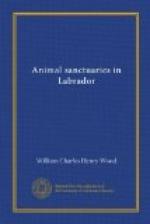Inland sanctuaries are more difficult to choose and manage. A deer sanctuary might answer near James bay. Fur sanctuaries must also be in some fairly accessible places, on the seaward sides of the various heights-of-land, and not too far in. The evergreen stretches of the Eastmain river have several favourable spots. What is needed most is an immediate examination by a trained zoologist. The existing information should be brought together and carefully digested for him in advance. There are the Dominion, Provincial and Newfoundland official reports; the Hudson Bay Company, the Moravian missionaries; Dr. Robert Bell, Mr. A.P. Low, Mr. D.I.V. Eaton, Dr. Grenfell, Dr. Hare, Mr. Napoleon Comeau, not to mention previous writers, like Packard, McLean and Cartwright—a whole host of original authorities. But their work has never been thoroughly co-ordinated from a zoological point of view. A form of sanctuary suggested for the fur-bearing Yukon is well worth considering. It consists in opening and closing the country by alternate sections, like crops and fallow land in farming. The Indians have followed this method for generations, dividing the family hunting grounds into three parts, hunting each in rotation, and always leaving enough to breed back the numbers. But the pressure of the grab-all policy from outside may become irresistible.
The one great point to remember is that there is no time to lose in beginning conservation by protecting every species in at least two separate localities.
A word as to the management and wardens. Two zoologists and twenty men afloat, and the same number ashore, could probably do the whole work, in connection with local wardens. This may seem utterly ridiculous as a police force to patrol ten Englands and three thousand miles of sea. But look at what the Royal North West Mounted Police have done over vast areas with a handful of men, and what has been effected in Maine, New Brunswick and Ontario. Once the public understands the question, and the governments mean business, the way of the transgressor will be so hard—between the wardens, zoologists and all the preventive machinery of modern administration—that it will no longer pay him to walk in it. Special precautions must be taken against that vilest of all inventions of diabolical ingenuity—the Maxim “silencer.” No argument is needed to prove that silent firearms could not suit crime better if they were made expressly for it. The mere possession of any kind of “silencer” should constitute a most serious criminal offence. The right kind of warden will be forthcoming when he is really wanted and is properly backed up. I need not describe the wrong kind. We all know him, only too well.
BENEFITS
I am afraid I have already exceeded my allotted time. But, with your kind indulgence, Sir, I should like, in conclusion, simply to enumerate a few of the benefits certain to follow the introduction and enforcement of law and the establishment of sanctuaries.




